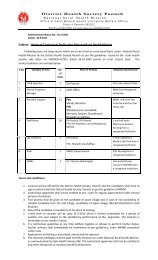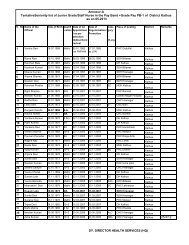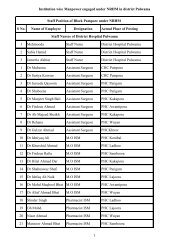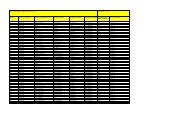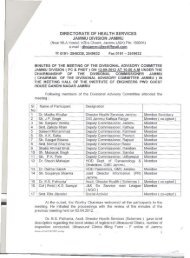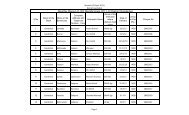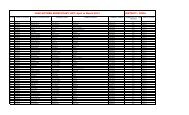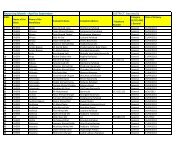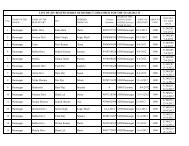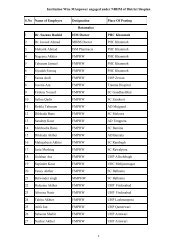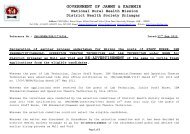Guidelines for Setting Up Blood Storage Centres - NRHM Tripura
Guidelines for Setting Up Blood Storage Centres - NRHM Tripura
Guidelines for Setting Up Blood Storage Centres - NRHM Tripura
Create successful ePaper yourself
Turn your PDF publications into a flip-book with our unique Google optimized e-Paper software.
STANDARD OPERATING PROCEDURES<br />
4. Mix the contents of the tubes and incubate tube • Ward No.<br />
no. 1 at room temperature <strong>for</strong> 5-10 minutes • Bed No.<br />
(immediate spin method) or <strong>for</strong> 45-60 minutes<br />
<strong>for</strong> saline room temperature technique.<br />
• ABO & Rh <strong>Blood</strong> Group<br />
5. Incubate tube no. 2 at 37ºC <strong>for</strong> 45 minutes DONOR UNIT NUMBER<br />
(indirect antiglobulin technique).<br />
• Donor ABO & Rh <strong>Blood</strong> Group<br />
6. Centrifuge the tube no. 1 at 1000 rpm <strong>for</strong> 1 • Expiry Date<br />
minute (immediate spin technique) while in • Date of Cross-match<br />
saline room temperature technique • Initials of the Technician cross matching the<br />
centrifugation is optional.<br />
blood.<br />
7. Examine the tube no. 1 <strong>for</strong> haemolysis or The satellite blood centre should maintain the record<br />
agglutination. If haemolysis or agglutination is of each unit of blood issued in a proper Register.<br />
present, cross-match is incompatible. If no • Name of Patients<br />
haemolysis or agglutination is seen, wait till the<br />
incubation of tube no. 2 is complete.<br />
• Hospital registration No.<br />
8. Examine the tube no. 2 <strong>for</strong> any haemolysis or<br />
• Ward<br />
agglutination; if negative wash the contents of • Bed<br />
the tube no. 2 three times with saline and • <strong>Blood</strong> Group<br />
decant the last wash completely. • Donor unit No. Issued<br />
9. Add 1 drop of anti-human globulin (AHG) • <strong>Blood</strong> group of donor unit / component<br />
reagent and centrifuge at 1000 rpm <strong>for</strong> 1 minute<br />
• Date & time of issue<br />
and look <strong>for</strong> haemolysis or aggluatination • Name & Signature of person who has issued the<br />
macroscopically & microscopically.<br />
blood<br />
10. Record the results.<br />
• Name & signature of person who has collected<br />
NOTE : Run Auto Control i.e., patient’s serum & the blood from the blood bank.<br />
patient’s washed red cells (3-4%).<br />
It is advisable to check each & every unit be<strong>for</strong>e issue<br />
<strong>for</strong> any change in colour or haemolysis, leaks, etc., &<br />
also issue a cross-match report along with the blood<br />
unit.<br />
INTERPRETATION :<br />
No haemolysis or agglutination indicates<br />
compatible cross-match, while haemolysis or The clinician in charge of the patient should be<br />
agglutination indicates incompatible cross-match. advised to send the reaction <strong>for</strong>m completely filled,<br />
in case of any reaction <strong>for</strong> evaluation.<br />
LABELING & ISSUE OF BLOOD<br />
INVESTIGATION OF A TRANSFUSION REACTION<br />
Be<strong>for</strong>e issuing a unit of blood <strong>for</strong> any patient <strong>for</strong><br />
In case of a suspected transfusion reaction the<br />
transfusion, it should be properly labeled. following things are to be done :<br />
The label should have the following in<strong>for</strong>mation.<br />
Things to be done in the ward by the sister<br />
• Name of the patient immediately.<br />
• Hospital Registration No. (I.D. No.) • Stop the transfusion<br />
22



